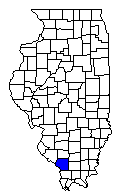
JUDGE WILLIAM WILLS BARR. The bench and bar of Illinois have in several
generations been adorned with names enjoying world-wide distinction, and a
worthy representative of the profession is Judge William Wills Barr, of
Carbondale, whose native ability and experience have fitted him for the
various positions he has filled, in which he has met grave questions with
good judgment and general satisfaction. Judge Barr is a native of
Pennsylvania, his birth having occurred in Center county May 8, 1845. His
parents were James S. and Charlotte B. (Stage) Barr, also natives of Center
county, Pennsylvania. The father was a man of ability and culture, and his
useful life was devoted to teaching, the subject benefitting greatly from
his enlightened tutelage. Judge Barr passed the usual number of terms behind
a desk in the village school room, and having come to a conclusion as to the
profession he meant to follow he matriculated in the Bloomington (Indiana)
Law School, from which institution he was graduated in 1867, at the age of
about twenty-two years. He had first begun his legal studies the year
previous in the office and under the direction of Hon. F. M. Youngblood, of
Benton, Franklin county, Illinois. In April, 1867, he was admitted to the
bar and opened an office in Benton, where he met the usual fortunes of
ambitious young barristers, the dull days being followed by the acquirement
of prestige and practice. He continued to reside in Benton for almost a
decade and in 1876 removed to Carbondale, where he has ever since made his
home. His success has been the logical outcome of his excellent equipment,
which gained him early recognition as one of the ablest of Jackson county
lawyers. He has a good legal mind and a strong power in marshalling and
presenting significant facts so as to bring conviction. His good standing as
a lawyer has been stamped with approval by his elevation to the bench, his
eight years' service as judge of the county court of Jackson county, being
bounded by the years 1886 and 1894. In the meantime he administered the law
with a fair and impartial hand and won highest commendation of the bar,
regardless of political affiliation.
Judge Barr is one of the local
standard bearers of the Democratic party and from his earliest years he has
been loyal to its articles of faith, having pored over the pages of its
history and found inspirations in its high traditions. A man of public
spirit of the type which has ever found expression in deeds rather than
words, it is small wonder that he should have been selected for several
positons of public trust. In 1866 he was appointed master of chancery of
Franklin county, for a term of two years, and in 1870 was elected to.,
represent his district in the twenty-seventh general assembly of Illinois.
In 1872 he was elected state's attorney of Franklin county, filling that
positon for four years, and in 1886 he was elected county judge of Jackson
county, in which office he was continued by reelection until 1894.
Almost since the attainment of his majority Judge Barr has been a member of
the Masonic fraternity, and he has ever exemplified in his own living those
ideals of moral and social justice and brotherly love for which the order
stands. He is also associated with the Ancient Order of United Workmen and
has been grand dictator of the Knights of Honor for the state of Illinois.
On October 15, 1870, he was married at Tamaroa, Perry county, to
Miss Alice G. Breinzer, a native of Philadelphia, and their ideally happy
union has been blessed by the birth of two daughters, Jessie G. and Bertha
A. Their home is a hospitable one and the members of their household enjoy
an enviable position in social circles where true worth and intelligence are
received as the passports into good society. The judge is a very popular
citizen, his honorable life and commendable characteristics, combined with a
genial, kindly manner, having won him a host of warm friends.
Extracted 15 Jan 2018 by Norma Hass from 1912 A History of Southern Illinois, volume 2, pages 817-818.
Randolph |
Perry | Franklin |
Perry MO |
 |
Williamson |
| Union |


